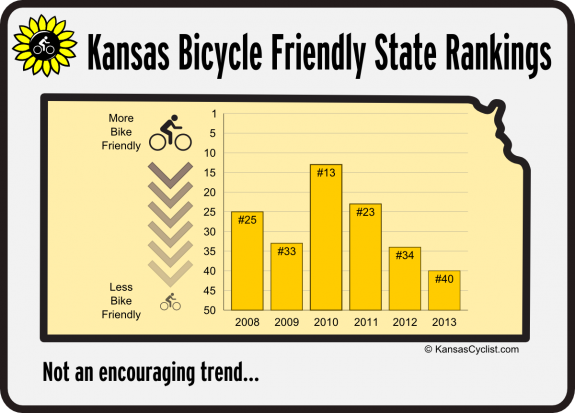 The League of American Bicyclists has just released the 2013 edition of their Bicycle Friendly State rankings, and Kansas has dropped from #34 to #40, a precipitous fall from just three years ago, when Kansas was ranked #13 in the nation.
The League of American Bicyclists has just released the 2013 edition of their Bicycle Friendly State rankings, and Kansas has dropped from #34 to #40, a precipitous fall from just three years ago, when Kansas was ranked #13 in the nation.
Here’s how the League graded the state:
- Legislation and Enforcement: 2
- Policies and Programs: 2
- Infrastructure and Funding: 1
- Education & Encouragement: 2
- Evaluation & Planning: 1
All grades are on a 5-point scale (1=low, 5=high).
If a teacher were grading Kansas, an average of 1.6 out of 5 would be a 32%, far below even an “F” on the standard grading scale.
If grading on a curve, Kansas would perhaps earn a “D-“, if the teacher were feeling charitable…
Not an Encouraging Trend
In 2008, Kansas was ranked #25. In 2009, we dropped to #33. In 2010, we jumped way up to #13. In 2011, we slipped to #23. 2012 saw a big drop to #34. Now we sink even further to #40.
Here is the trend, visually:
It’s ugly. It’s embarrassing.
Why Has Our Bicycle Friendly Ranking Dropped?
The biggest part of the explanation is that other states are continuing to improve, but progress has stalled in Kansas.
After the excitement and momentum gained by passage of the 2011 safe-passing law, and the opening of some excellent bicycling facilities in a few places in the state, nothing much happened in 2012, in terms of policy or projects.
However, 2012 saw the states’s first silver-level Bicycle Friendly Business, and a new Bicycle Friendly Community in Manhattan.
But 2013 hasn’t been much better, on the state level. We have a new state bike/ped plan in progress, but otherwise, no legislation in this session. And no big bike projects in progress.
We’ve seen some encouraging progress in the cities, with new bike plans in Wichita, Hays, and (soon) Valley Center, and positive developments in Iola, Pittsburg, and Kansas City. And the trails network is ever-expanding.
So there is some progress, but we still have a state Department of Transportation (KDOT) that too often talks a better game than it plays. We hear the right things about improving bike/ped transportation, but there is not a lot of concrete progress to show for it yet. Streets, roads, and highways are still routinely built with little consideration given to non-motorized transportation.
Of course, improving the bicycle friendliness of the state hasn’t been a priority for the Kansas legislative or executive branches, either. (And you’d hope that it would, given the extremely low costs and high return-on-investment for bike/ped projects, compared to most other transportation infrastructure.)
The State Legislature and Governor’s Office adopted the current transportation plan, T-LINK, and construction program, T-WORKS, which was developed by KDOT. The plan places no priority on bicycle and pedestrian transportation, and consequently, T-WORKS does not include any state funding for bicycle and pedestrian transportation projects.
Any money spent on bicycling and pedestrian transportation projects in Kansas is either pass-through dollars from the federal government, or local funds — Kansas has never invested any state transportation funds to build any of the few critical safety facilities we currently have.
Historically, money spent on bicycling and pedestrian transportation projects in Kansas is either pass-through dollars from the federal government, or local funds — not state funds — for critical safety facilities.
Kansas still has no silver, gold, or platinum-level bicycle friendly communities, and the number of bicycle friendly businesses is still rather small. None of our colleges have made the Bicycle Friendly University list.
How Can Kansas Improve?
The LAB’s Kansas BFS Report Card offers these suggestions for improvement:
- Adopt a vulnerable road user law that increases penaltiesfor a motorist that injures or kills a bicyclist or pedestrian.
- Repeal the state’s mandatory sidepath law. Most sidepaths are designed for recreational use and are not convenient for transportation purposes.
- Adopt a statewide, all-ages cell phone ban to combat distracted driving and increase safety for everyone.
- Adopt performance measures,such as mode shift or a low percentage of exempted projects, to better track and support Complete Streets/Bike Accommodation Policy compliance.
- Adopt a statewide policy that requires bicycle accommodations on all bridge and tunnel projects.
- The state is spending a low amount of federal funding on bicyclists and pedestrians. Adopt federal funding project rating criteria that incentivize bicycle projects and accommodations Dedicate state funding for bicycle projects and programs, especially those focused on safety and eliminating gaps and increasing access for bicycle networks.
- Add language to the driver’s license manual, classes, and tests that addresses the interaction between vehicles and bicycles.
- Adopt performance measures to decrease bicycle fatalities.
- Adopt a mode share goal for biking to encourage the integration of bicycle transportation needs into all transportation and land use policy and project decisions.
How Are Our Neighbors Doing?
Here’s what happened with the Bike Friendly States rankings in nearby states:
- Arkansas: #37 (#50 in 2012)
- Colorado: #2 (#4 in 2012)
- Iowa: #21 (#16 in 2012)
- Missouri: #30 (#28 in 2012)
- Nebraska: #41 (#43 in 2012)
- Oklahoma: #35 (#43 in 2012)
Other than Colorado, and to a lesser extent Iowa, Kansas is in a pretty low-ranked region.
That doesn’t help. When Kansas legislators look at our peers and see them stuck in the same rut and same regressive thinking, they must think of that as “normal”. It’s not. It’s failing.
Why Should Kansas Become Bicycle-Friendly?
This blurb from the Bicycle Friendly America brochure sums it up pretty well:
New businesses and potential residents aren’t just looking at tax rates and school districts anymore; they want to settle in a state with rich outdoor opportunities and safe transportation options for their entire family or workforce. The Bicycle Friendly States program helps government officials and advocates improve bicycling conditions and enhance quality of life.
Bicycling means business: Bicycle tourism can be a major driver of economic development, and corporations can capitalize on reduced healthcare costs. By making streets comfortable and accessible for cyclists, bicycle friendly states increase the afety of all road users and give residents transportation choices that save money and improve health.
Any thoughts on how Kansas can move forward, rather than falling further and further behind?
See also: Bicycle Friendly States Ranking Announced!, 2013 state grades by category.
Post tags: Bicycle Friendly, NewsBlog



